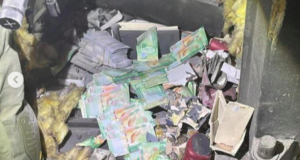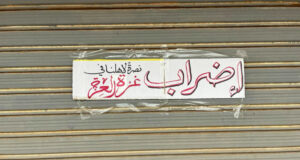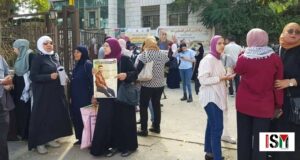by Sylvester Brown Jr. St. Louis Post, 08/29/2006
The woman’s defiant stance – back arched, arms outstretched – seemed to say, “Bring it on!” Yet, the scene seemed to betray her resolve. St. Louis County resident Jennifer Presson, 24, stood in front of a line of Israeli soldiers. They were armed with batons, guns and Plexiglas body shields.
The photos were sent to me via e-mail. One shows Presson being knocked aside by advancing shields. She included a detailed description of her encounter:
“I stayed in front of them with my arms wide out to the side, trying to stand still. They pushed, I stumbled, they pushed, I stumbled and stood again. . . . they started beating me with batons.”
Presson was one of two St. Louis women involved in Friday’s protest march in Bil’in village, west of Ramallah, in the northern part of the West Bank. They are members of the International Solidarity Movement, a group of activists founded in 2001, dedicated to “nonviolent resistance to Israeli occupation of Palestinian farmland.” Operating under the theory that the media will be more sympathetic when Westerners are involved, some ISM members believe their presence ensures a degree of protection for the Palestinians.
However, the Anti-Defamation League’s website lists the ISM as a “well-organized movement that spreads anti-Israel propaganda and misinformation” while supporting those engaged “in armed resistance against Israel.”
I’m not taking any sides and don’t pretend to understand the complexity of the Palestinian-Israeli conflict. Presson’s e-mail presented a disturbing front-line account of the protest marches, which, she says, have occurred every Friday since January 2005. The impassioned plea attached at the end of her e-mail was hard to ignore:
“If you know anyone in the media, please pass this on . . .”
Members of the ISM, which received international attention in 2002 when they entered the Church of the Nativity in Bethlehem during a standoff between Israeli and Palestinian forces, place themselves in the midst confrontations, hoping to discourage bloodshed.
It doesn’t always work.
In another photo Presson sent, she’s seen crouched on the ground with other activists and villagers, as soldiers pummel them with batons. After the clash, Presson is photographed displaying wounds received in her right hip and lower back – from rubber-coated bullets fired by soldiers.
“Normally, my white skin and international passport is a huge ‘Don’t shoot here’ sign,” Presson wrote. “I heard the BOOMs, I heard screams . . . I felt the first bullet . . . the next one hit my back. I limped towards the stone wall to my left, hoping to be out of their sight.”
It was late at night in Beit Ommar village, in the northern part of the West Bank, when I reached Presson by phone Sunday. Dogs yapped in the background as she described the village she now calls home.
“There’s all kinds of animals here – dogs, chickens, sheep, goats . . . cats everywhere,” Presson said.
We discussed the gap from 2003, after she graduated from St. Louis University with a nursing degree, to her current role as a Middle East activist. She started to “question things” after 9/11 and the start of the Iraq war. Those answers turned to outrage, and that outrage turned to action for her. She wasn’t trying to be a hero when she confronted the soldiers, Presson said, admitting her daily fear: “I pray that I’m not killed. I ask often ask myself, ‘What am I doing here?’ I’m from St. Louis County, for God’s sake.
“But the Palestinians’ fear is greater than my fear. They often say they have no hope, no dreams, no life. Anybody seeing what I’ve seen would recognize the injustice,” she said.
Presson considers herself lucky. Unlike the Palestinians, she has the privilege of getting on a plane and escaping “the insanity.” When she returns to the United States in October, Presson said, she will continue to dedicate her time to presenting an accurate depiction of the Israeli and Palestinian conflict. Most Americans are woefully unaware, she said. And that is the reason she’s in the Middle East today:
“If our journalists, politicians and soldiers aren’t going to do anything . . . somebody has to.”
 International Solidarity Movement Nonviolence. Justice. Freedom.
International Solidarity Movement Nonviolence. Justice. Freedom.


